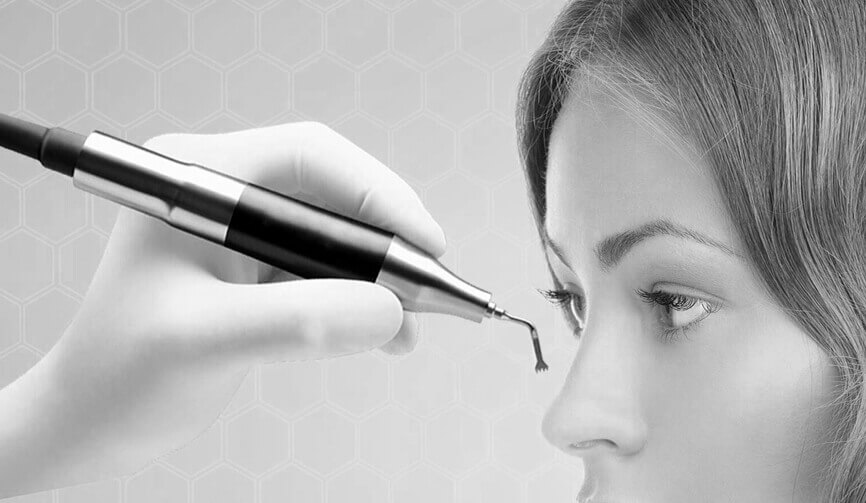Rhinoplasty is one of the most common cosmetic surgeries done around the world and the concern of most patients is to have the best results with the least invasive methods and fastest recovery time. With advancing technology we are getting closer to achieving these goals every day. One of these new technologies is called ultrasonic rhinoplasty. In this article we will discuss about what this method is and what benefits it has compared to traditional rhinoplasty.
Table of Contents
ToggleWhat is ultrasonic rhinoplasty?
Ultrasonic rhinoplasty, also known as rhinosculpture or Piezoelectric rhinoplasty was developed in 2013 by Dr. Gerbault and approved by FDA- in November 2017.
In this method high speed sound waves, make vibrations that slowly cut, shape, and polish the hard cartilage and bony structures of the nose without damaging the surrounding soft nose tissue.
This process is performed by piezoelectric inserts (PEI) which is an ultrasound device that has ergonomic tips called Piezotome.
Ultrasonic rhinoplasty provides a highly accurate result and reduces the likelihood of revision rhinoplasty at a later date.
How is ultrasonic rhinoplasty done?
It is performed as an outpatient procedure but you’ll be under general anaesthesia and it usually takes between two or three hours. The procedure involves opening the skin on the nose and exposing the bone and cartilage. After that a small incision is made on the columella (the piece of skin between your nostrils) for optimal access and visualization. Then PEI is inserted on different parts of the nose that need reducing or reshaping and Piezoelectric-powered ultrasonic waves will then be applied to create precise and symmetric bone cuts to refine the nasal bridge, reduce the length or projection of the nose, remove a nasal hump, and polish rough surfaces on your nose. It can also be used to treat nasal deviation.
This is a very precise surgical technique and allows for more accurate contouring of the nasal bones. Only bone can absorb the ultrasonic energy, so there is no damage to the surrounding tissues, upper and lower cartilages, blood vessels and mucosal lining.
Therefore, by avoiding damage to these surrounding soft tissues, the procedure results in less bruising, bleeding and swelling than traditional rhinoplasty procedures. You can see appreciable result between 1 and 3 months after surgery but the final result will be obtained 1 year after surgery.
What are the benefits of ultrasonic rhinoplasty?
Using piezoelectric technology reduces swelling and bruising after rhinoplasty by minimizing damage to the surrounding soft tissue, therefore you’ll heal faster and you’ll be able to do your daily activities and go back to work within a week but you should avoid strenuous activity and exercise for the first several weeks.
With ultrasonic rhinoplasty you’ll experience less pain and discomfort after the surgery.
The surgeon has perfect control while cutting and reshaping the nasal bone and there is no risk of unwanted fractures.
That provides a more detailed cosmetic outcome and more natural-looking results. Hence, there is less likely a need for revision rhinoplasty.
Ultrasonic rhinoplasty can be used to treat thin, fragile and brittle bones or bones that have been already broken previously during a nasal trauma or a surgery (which is very difficult with traditional methods).
Ultrasonic rhinoplasty can also be done as a revision rhinoplasty if you are not satisfied with the results of your first nose job. It can also accurately treat nasal bones asymmetry.
Ultrasonic rhinoplasty can also be used to correct functional issues such as breathing difficulties or nasal congestion.
What is the difference between ultrasonic rhinoplasty and traditional rhinoplasty?
Ultrasonic rhinoplasty is a relatively new technique for performing nose surgery, while traditional rhinoplasty has been the standard approach for many years.
Ultrasonic rhinoplasty falls into the category of preservation rhinoplasty, which aims to reshape the bone instead of breaking it, as opposed to old-fashioned techniques.
During traditional hump reduction rhinoplasty, rasps, chisels, and hammers are usually used to remove bone and cartilage and reshape the nose which may have some consequences such as splintering of the nasal bones and therefore causing accidental fractures or creating additional trauma to surrounding nasal tissue which can contribute to swelling, bruising, bleeding and additional scarring.
In contrast, by using PIE during ultrasonic rhinoplasty, the surgeon will have better precision and control during the procedure and will be able to cut or remove nasal bones with high precision.
What are the advantages and disadvantages of ultrasonic Rhinoplasty?
The device used in it (PIE), can only be used in open rhinoplasty procedures (which is more invasive compared to closed rhinoplasty), therefore the surgeon has to undermine the skin of the nose more extensively to fit the device.
The ultrasonic rhinoplasty technique is not suitable for fixing the nasal tip and is not ideal for cartilage adjustments requiring graft techniques because the piezotome will not cut or reshape the soft cartilage of the tip. Therefore, if you only need tip surgery, ultrasonic rhinoplasty may not be right for you.
Ultrasonic rhinoplasty provides the most predictable outcomes compared to other methods of rhinoplasty.
Is ultrasonic rhinoplasty more expensive than traditional rhinoplasty?
The cost of ultrasonic rhinoplasty depends on the complexity of the patient’s case and how much work the nose needs, the used instruments, the surgeon’s experience and skill level, and the facility where the nose surgery is performed. In general, ultrasonic rhinoplasty may cost more than traditional rhinoplasty because it’s a newer and more advanced technique that requires specialized equipment and training. However, you should contemplate the benefits of this method -which were mentioned earlier- and not decide just based on the price.
Which rhinoplasty technique is best?
There are many different techniques for performing rhinoplasty and each one has some advantages and disadvantages. Each nasal condition has a preferred technique. For example only patients who require a reduction or adjustment of the nasal structure (such as hump reduction, adjustment of septum deviations, bone irregularities, and narrowing the bony midvault.) are suitable for ultrasonic rhinoplasty. The best choice for every patient is different based on their condition and also what they expect from the surgery. Consulting with an experienced rhinoplasty surgeon is a safe way to help you choose which method is suitable for your needs.
Ultrasonic rhinoplasty is considered a revolution in aesthetic nose surgery but it requires an artistic eye and considerable skill to perform with excellent results. In Mediranco, we will provide you consultation with the best rhinoplasty surgeons who perform ultrasonic rhinoplasty and during your consultation you can discuss about your condition and expectations and then the surgeon will suggest the best method for you to get the best possible outcome. You can also use a 3D rhinoplasty digital simulation during your consultation, and then you can see a visualization of your final result which will make you have realistic expectations from the surgery. If you have any further questions regarding ultrasonic rhinoplasty, you can contact our support team and they will help you through.

Rhinoplasty cost in Iran
- Treatment visa
- Simcard with internet
- Medicines
- Airport pickup
- Transportation
- Medical Photography
- Medical interpreter
- 24/7 on phone Translator
Surgery : 1630$
4 Stars Hotel: 1840$
5 Stars Hotel: 1990$

